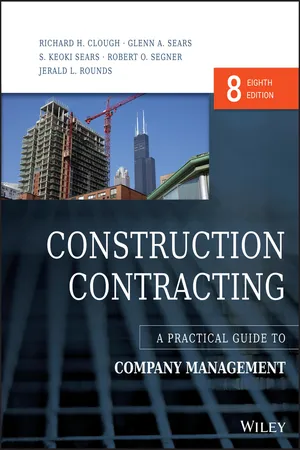
Construction Contracting
A Practical Guide to Company Management
- English
- ePUB (mobile friendly)
- Available on iOS & Android
Construction Contracting
A Practical Guide to Company Management
About this book
Construction Contracting, the industry's leading professional reference for five decades, has been updated to reflect current practices, business methods, management techniques, codes, and regulations. A cornerstone of the construction library, this text presents the hard-to-find information essential to successfully managing a construction company, applicable to building, heavy civil, high-tech, and industrial construction endeavors alike. A wealth of coverage on the basics of owning a construction business provides readers with a useful "checkup" on the state of their company, and in-depth exploration of the logistics, scheduling, administration, and legal aspects relevant to construction provide valuable guidance on important facets of the business operations. This updated edition contains new coverage of modern delivery methods, technology, and project management.
The field of construction contracting comprises the entire set of skills, knowledge, and conceptual tools needed to successfully own or manage a construction company, as well as to undertake any actual project. This book gives readers complete, up-to-date information in all of these areas, with expert guidance toward best practices.
- Learn techniques for accurate cost estimating and effective bidding
- Understand construction contracts, surety bonds, and insurance
- Explore project time and cost management, with safety considerations
- Examine relevant labor law and labor relations techniques
Between codes, standards, laws, and regulations, the construction industry presents many different areas with which the manager needs to be up to date, on top of actually doing the day-to-day running of the business. This book provides it all under one cover – for the project side and the business side, Construction Contracting is a complete working resource in the field or office.
Frequently asked questions
- Essential is ideal for learners and professionals who enjoy exploring a wide range of subjects. Access the Essential Library with 800,000+ trusted titles and best-sellers across business, personal growth, and the humanities. Includes unlimited reading time and Standard Read Aloud voice.
- Complete: Perfect for advanced learners and researchers needing full, unrestricted access. Unlock 1.4M+ books across hundreds of subjects, including academic and specialized titles. The Complete Plan also includes advanced features like Premium Read Aloud and Research Assistant.
Please note we cannot support devices running on iOS 13 and Android 7 or earlier. Learn more about using the app.
Information
Chapter 1
The Construction Industry
1.1 Introduction
1.2 The Construction Project
1.3 Economic Importance
1.4 The People Involved on a Construction Project
1.4.1 Owner

Table of contents
- Cover
- Title Page
- Copyright
- Table of Contents
- Chapter 1: The Construction Industry
- Chapter 2: Business Ownership
- Chapter 3: Company Organization
- Chapter 4: Project Design and Contract and Bid Documents for a Project
- Chapter 5: Cost Estimating and Bidding
- Chapter 6: Construction Contract Provisions
- Chapter 7: Contract Surety Bonds
- Chapter 8: Construction Insurance
- Chapter 9: Business Methods
- Chapter 10: Project Management and Administration
- Chapter 11: Project Time Management
- Chapter 12: Project Cost Management
- Chapter 13: Labor Law
- Chapter 14: Labor Relations
- Chapter 15: Project Safety
- Appendix A: Instructions to Bidders
- Appendix B: AIA Document B101-2007 Standard Form of Agreement between Owner and Architect
- Appendix C: Construction Specification Institute MasterFormat 2014
- Appendix D: AIA Document A201-2007 General Conditions of the Contract for Construction
- Appendix E: Supplementary Conditions
- Appendix F: Sample Lump-Sum Proposal Form, with Reference to Addenda, and Alternates
- Appendix G: AIA Document A101-2007 Standard Form of Agreement between Owner and Contractor Where the Basis of Payment is a Stipulated Sum
- Appendix H: AIA Document A102-2007, Standard Form of Agreement between Owner and Contractor Where the Basis of Payment is the Cost of the Work Plus a Fee with a Guaranteed Maximum Price
- Appendix I: AIA Document A310-2010 Bid Bond
- Appendix J: AIA Document A312-2010 Performance Bond
- Appendix K: AIA Document A312-2010 Payment Bond
- Appendix L: AGC Document 655 Standard Form of Agreement between Contractor and Subcontractor
- Appendix M: AIA A401-2007 Standard Form of Agreement between Contractor and Subcontractor
- Appendix N: Construction Industry Arbitration Rules and Mediation Procedures of the American Arbitration Association
- Appendix O: Typical Construction Company General Ledger Accounts
- Index
- End User License Agreement